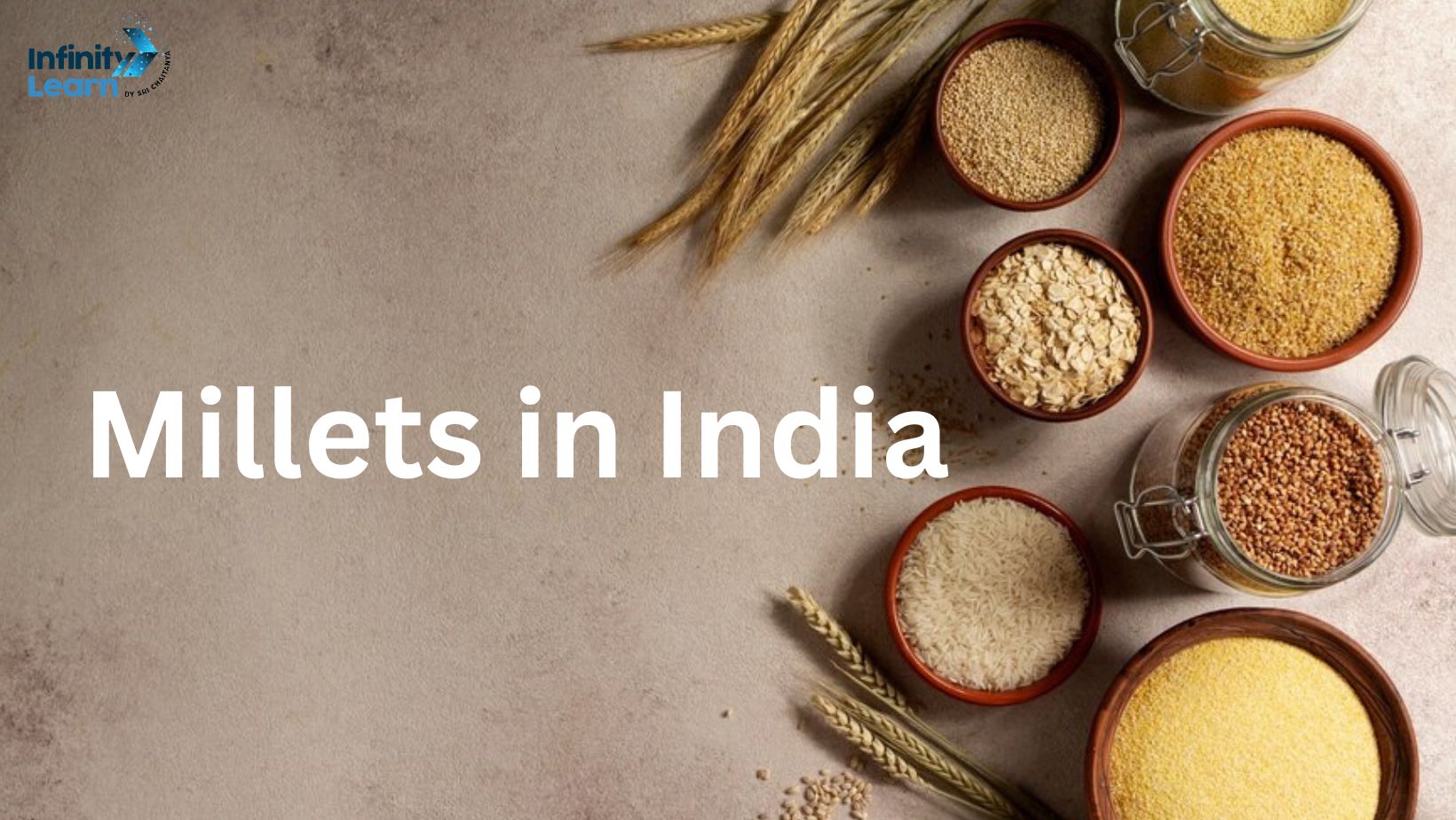Table of Contents
Millets are a type of healthy grains that don’t contain gluten and have been cultivated and eaten in India for many years. They’re among the earliest grains people cultivated and have mainly been grown in dry parts of India. India is a big producer and consumer of millets globally. Some common types grown here include pearl millet (bajra), finger millet (ragi), foxtail millet (kangni), little millet (kutki), and proso millet (cheena).
2024 is designated as the International Year of Millets following India’s proposal to the Food and Agriculture Organization (FAO), which was accepted. Over the past sixty years, the cultivation of millets has decreased despite advancements in agriculture during the 1960s. Nevertheless, productivity has increased thanks to the introduction of high-yield varieties and improved technologies. Explore more about millets in India to enhance your understanding, which can be beneficial for various government exams.
Millets in India
Millets have been important in India for a long time. These grains, like pearl millet, foxtail millet, and finger millet, grow well even in dry areas. They’re full of nutrients and can help fight hunger. Recently, more people are interested in them because they’re good for health and can help when food is scarce.
What are Millets in India?
Millets are packed with nutrients like protein, fiber, minerals, and vitamins. They’re gluten-free and have a low glycemic index, which is great for people with gluten intolerance or diabetes. Lately, there’s been a lot of focus on millets because they’re healthy and can withstand different climates. The Indian government is supporting millet farming and consumption through various programs, like including them in the Public Distribution System and the National Food Security Mission. If you want to learn more about millets and Static Gk in India, keep reading this article.
Types of Millets in India
India grows many different types of millets that people eat in different parts of the country. Here are some of them:
- Pearl Millet (Bajra): This type of millet is common in dry areas of India. People use it to make foods like flatbread, known as roti.
- Foxtail Millet (Kangni): This millet is small and yellowish-brown. It’s common in the southern states and used to make foods like porridge and a sweet dish called kheer.
- Finger Millet (Ragi): People in the southern states of India often eat this type of millet. It’s good for you because it has a lot of calcium and iron. People make foods like pancakes and steamed cakes with it.
- Barnyard Millet (Sanwa): This millet is small and white. It’s grown in hilly areas and used to make foods like pancakes and steamed cakes, similar to finger millet.
- Proso Millet (Cheena): This millet is small and yellow. It’s common in the northern and western parts of India and used to make foods like flatbread and a rice-like dish called khichdi.
- Little Millet (Kutki): This millet is small and round. It’s grown in hilly areas and used to make dishes like a kind of rice dish called pulao.
By using these millets, people in India make a variety of delicious and nutritious dishes.
List of Millets in India
| Millet Type | Hindi Name | Region of Cultivation | Nutritional Value | Common Uses and Dishes |
|---|---|---|---|---|
| Foxtail Millet | Kangni/Motki | Tamil Nadu, Andhra Pradesh, Karnataka, Odisha, Maharashtra, Madhya Pradesh | High in protein, fiber, and minerals such as copper and iron | Upma, Pongal, Kheer, Pulao |
| Barnyard Millet | Sanwa | Uttar Pradesh, Rajasthan, Madhya Pradesh, Gujarat, Karnataka, Tamil Nadu | Rich in fiber, protein, and minerals such as calcium and phosphorus | Khichdi, Dosa, Idli, Upma |
| Little Millet | Kutki | Karnataka, Tamil Nadu, Maharashtra, Uttar Pradesh, Uttarakhand | Rich in fiber, protein, and minerals such as potassium and magnesium | Khichdi, Pulao, Upma, Kheer |
| Proso Millet | Cheena | Uttar Pradesh, Rajasthan, Haryana, Gujarat, Maharashtra, Karnataka, Tamil Nadu | High in protein, fiber, and minerals such as iron and phosphorus | Roti, Khichdi, Kheer, Porridge |
| Sorghum Millet | Jowar | Maharashtra, Karnataka, Telangana, Andhra Pradesh, Tamil Nadu, Madhya Pradesh | High in fiber, protein, and minerals such as phosphorus and iron | Roti, Bhakri, Khichdi, Porridge |
| Kodo Millet | Kodra | Maharashtra, Odisha, Uttar Pradesh, Tamil Nadu, Andhra Pradesh, Telangana | High in protein, fiber, and minerals such as iron and calcium | Khichdi, Pulao, Upma, Kheer |
| Pearl Millet | Bajra | Rajasthan, Haryana, Gujarat, Maharashtra, Uttar Pradesh, Punjab | High in fiber, protein, iron, magnesium, and calcium | Roti, Bhakri, Khichdi, Porridge |
| Finger Millet | Ragi | Karnataka, Tamil Nadu, Andhra Pradesh, Telangana, Kerala | High in calcium, iron, fiber, and protein | Ragi Mudde, Dosa, Idli, Porridge |
Advantages of Millet production in India
Millets are often called coarse grains, but because of their nutrition, they are now called ‘nutria-millets’ or ‘nutria-cereals’. Here are some benefits of growing millets in India:
- Survive Tough Conditions: Millets can grow in tough conditions and don’t need much water, making them great for areas with less rainfall.
- Dual Purpose: Millets are useful for both food and animal feed, which helps many families and makes farming more efficient.
- Climate Friendly: Growing millets can help reduce CO2 in the air, unlike wheat and rice which contribute to climate change.
- Chemical-Free: Millet production doesn’t need harmful chemicals, and the crops aren’t easily attacked by pests or damaged during storage.
- Nutrition Powerhouse: Millets are packed with nutrients like vitamins, minerals, and fiber. They’re much better for you than wheat and rice.
- Health Benefits: Eating millets can help fight obesity, lower the risk of diseases like high blood pressure, heart problems, diabetes, and certain cancers. They also help with digestion because they have lots of fiber and a low sugar content.
Millets in India FAQ’s
What is millet called in India?
Millet is called 'bajra' in India.
What are the 12 millets in India?
The 12 millets in India include bajra, jowar, ragi, kodon, kodo, sama, kutki, kodo, kangni, cheena, moraiyo, and sanwa.
Where is millet mostly grown in India?
Millet is mostly grown in the semi-arid regions of India, like Rajasthan, Maharashtra, Gujarat, and parts of Karnataka and Uttar Pradesh.
मिलेट में कौन कौन से अनाज होते हैं?
मिलेट में बाजरा, ज्वार, रागी, कोदों, सामा, कुटकी, कंगनी, चीना, मोरैयो, सांवा, और जौ जैसे अनाज होते हैं।
मिलेट्स का हिंदी नाम क्या है?
मिलेट्स का हिंदी नाम 'बाजरा' है।
मिलेट्स का दूसरा नाम क्या है?
मिलेट्स का दूसरा नाम 'बाजरा' है।
मिलेट्स खाने के क्या क्या फायदे हैं?
मिलेट्स खाने से हमें अधिक फाइबर, प्रोटीन, विटामिन, और मिनरल्स मिलते हैं जो हमारे स्वास्थ्य के लिए फायदेमंद होते हैं।
सबसे ज्यादा ताकतवर अनाज कौन सा है?
ज्वार और बाजरा मिलेट्स में सबसे ज्यादा ताकतवर होते हैं।
मिलेट्स में क्या क्या आते हैं?
मिलेट्स में फाइबर, प्रोटीन, विटामिन, और मिनरल्स आते हैं जो हमारे शारीरिक और मानसिक स्वास्थ्य के लिए फायदेमंद होते हैं।
How many millets are there in India?
There are many millets in India, but some popular ones include bajra, jowar, ragi, kodon, and sama.
What are the top 5 millets in India?
The top 5 millets in India are bajra, jowar, ragi, kodon, and sama.
फॉक्सटेल को हिंदी में क्या कहते हैं?
फॉक्सटेल को हिंदी में 'कंगनी' कहते हैं।
कंगनी खाने से क्या फायदा होता है?
कंगनी खाने से हमें अधिक फाइबर, प्रोटीन, और विटामिन मिलते हैं जो हमारे स्वास्थ्य के लिए फायदेमंद होते हैं।
फॉक्सटेल बाजरा का हिंदी नाम क्या है?
फॉक्सटेल बाजरा का हिंदी नाम 'कंगनी' है।
कंगनी अनाज को हिंदी में क्या कहते हैं?
कंगनी अनाज को हिंदी में 'फॉक्सटेल' कहते हैं।









